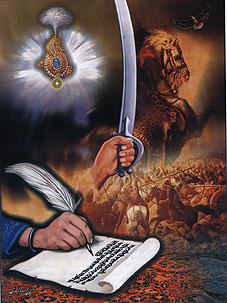FATEHNAMAH GURU KHALSA JI KA, by Ganesh Das, an employee of the Sikh Darbar, and published as edited by Sita Ram Kohli, contains accounts, in Punjabi verse, of three of the major battles of Sikh times. The first of these was fought at Multan in 1818 between Maharaja Ranjit Singh`s forces and the army of the local Afghan ruler Muzaffar Khan. The second, the first battle of Peshawar, also known as the battle of Naushera, was fought in 1823 between Sikhs and Muhammad`Azim Khan, who after the death of his brother Fateh Khan, had acquired power in Afghanistan and wished to reestablish Afghan supremacy over Peshawar.
The third, the second battle of Peshawar, was waged at Saidu, a few kilometers south of Akora, in 1826 between the Sikhs and Sayyid Ahmad`s host. The Sayyid who hailed from Rae Bareli, in present day Uttar Pradesh, had declared jihad against the Sikhs. Ganesh Das`s description of these engagements is embellished with conventional poetic devices, yet its historical core remains unimpaired. In fact, the details of the battles he has given correspond with those recorded in contemporary chronicles such as Twarikh-i-Maharaja Ranjit Singh, Umdat-ut-Twarikh, Zafar Nama-i-Ranjit Singh and Jang-i-Multan.
Ganesh Das has great admiration for Maharaja Ranjit Singh as well as for the Khalsa. His appraisal of the role of the Maharaja in the Sikh body politic is highly perceptive. For him Ranjit Singh was the leader of the Khalsa commonwealth rather than a Maharaja or sovereign, and he addresses him as Singh Sahib (exalted member of the Khalsa). Ganesh Das attributes victories won in these battles to the Khalsa as a whole and not to Ranjit Singh. Hence the title of his work: Fatehnamah Guru Khalsa Ji Ka, i.e. account of the victories of the Guru Khalsa.
“Epic Battles in Fatehnama Guru Khalsa Ji Ka” is an epic composition rendered in Punjabi verse that chronicles key military engagements of the Sikh Khalsa in the early 19th century. Attributed to Ganesh Das, this work not only celebrates martial valor but also encapsulates the collective spirit of the Guru Khalsa, offering a poetic retelling that harmonizes historical detail with devotional fervor.
The Three Pivotal Battles
- Battle of Multan (1818):
The first battle detailed in the Fatehnama was fought at Multan, where Maharaja Ranjit Singh’s forces clashed with the army of the local Afghan ruler, Muzaffar Khan. This confrontation showcased the strategic organization and determination of the Khalsa. The victory at Multan was emblematic of the emerging Sikh power in the region, illustrating how disciplined military tactics could overcome entrenched adversaries. - First Battle of Peshawar (1823) – The Battle of Naushera:
The second engagement, known as the first battle of Peshawar or the Battle of Naushera, pitted the Sikh forces against Muhammad Azim Khan. Following the demise of his brother Fateh Khan, Azim Khan endeavored to reassert Afghan dominance over Peshawar. The Fatehnama portrays this battle with vivid imagery, highlighting the resilience and martial prowess of the Khalsa as they thwarted this ambitious bid for supremacy. - Second Battle of Peshawar (1826) – The Battle at Saidu:
The third major battle in the narrative occurred at Saidu, just south of Akora. Here, the Sikh Khalsa faced off against Sayyid Ahmad—a figure who, hailing from Rae Bareli, declared jihad against the Sikhs. This battle reinforced the theme of collective valor, with the Fatehnama attributing victory not to a single leader but to the united strength of the Guru Khalsa. Poetic Narration and Historical Corroboration
Though Ganesh Das employs conventional poetic devices to enrich the narrative, the historical core of Fatehnama Guru Khalsa Ji Ka remains robust and well-aligned with contemporary chronicles such as Twarikh-i-Maharaja Ranjit Singh, Umdat-ut-Twarikh, and Zafar Nama-i-Ranjit Singh . His verses emphasize that the triumphs of these epic battles owe much to the solidarity and shared valor of the Khalsa, rather than solely to the leadership of Maharaja Ranjit Singh.
Legacy and Cultural Impact
The account captured in Fatehnama is much more than a mere record of military engagements—it is a testament to the spirit of resistance and the ethos of equality that defines Sikh martial tradition. These vivid depictions of epic battles serve as a source of communal pride and historical insight, inspiring both scholars and devotees. They not only celebrate past glories but also continue to offer lessons in unity, strategy, and the transformative power of collective action .



